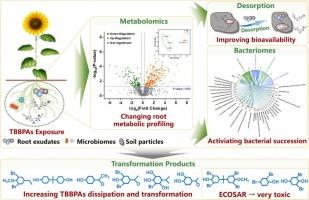Root exudates of Helianthus annuus enhanced Tetrabromobisphenol A derivatives transformation in rhizospheric soil: Insights from desorption behavior and bacteriome succession
IF 11.3
1区 环境科学与生态学
Q1 ENGINEERING, ENVIRONMENTAL
引用次数: 0
Abstract
Substantial alterations in the rhizosphere induced by root exudates can significantly influence the environmental behavior of tetrabromobisphenol A derivatives (TBBPAs) in soil-plant interface. However, the empirical evidence regarding the impact of root exudates on the transformation pathways of TBBPAs is notably scarce. The present study, through pot experiment, integrated root metabolome analysis, desorption kinetics and high-throughput sequencing technology to elucidate the mechanism of how actual root secretions mediate the environmental fate of TBBPAs in the soil-plant system from both macro and micro perspectives. The pot experiment indicated that compared with the natural attenuation, Helianthus annuus cultivation significantly enhanced TBBPAs dissipation efficiency by 55.24-58.89% after 45 days remediation, while facilitating formation of β-scission, oxidative cleavage, and O-methylation products. Root metabolomic analysis revealed a substantial shift in root exudates exposed to TBBPAs, which in turn induced the enrichment of specific TBBPA-degrading bacterial genera in the rhizosphere, including Sphingomonas, Rhizomicrobium, Saccharibacteria_genera_incertae_sedis, Parcubacteria_genera_incertae_sedis, Gaiella, and unclassified_Xanthomonadaceae. Crucially, this study provided the first empirical evidence that root exudates significantly enhance TBBPAs desorption from soil, uncovering a key plant-microbe interaction mechanism behind phytoremediation. These findings advanced our understanding of rhizosphere-mediated transformation processes of organic pollutants and provided critical data for ecological risk assessment in contaminated soil ecosystems.

向日葵根系分泌物促进了四溴双酚A衍生物在根际土壤中的转化:来自解吸行为和细菌群演替的见解
根系分泌物引起的根际变化可显著影响四溴双酚A衍生物(TBBPAs)在土壤-植物界面的环境行为。然而,关于根分泌物对tbbpa转化途径影响的经验证据明显缺乏。本研究通过盆栽试验,结合根代谢组学分析、解吸动力学和高通量测序技术,从宏观和微观两个角度阐明根实际分泌物介导tbbpa在土壤-植物系统中环境命运的机制。盆栽试验结果表明,与自然衰减相比,经过45 d的修复,向日葵的TBBPAs耗散效率显著提高55.24-58.89%,同时促进了β-断裂、氧化裂解和o -甲基化产物的形成。根代谢组学分析显示,暴露于tbbpa的根分泌物发生了实质性的变化,从而诱导根际中特定的tbbpa降解细菌属的富集,包括Sphingomonas、Rhizomicrobium、Saccharibacteria_genera_incertae_sedis、Parcubacteria_genera_incertae_sedis、Gaiella和unclassified_Xanthomonadaceae。至关重要的是,本研究首次提供了经验证据,证明根系分泌物显著增强了土壤中tbbpa的解吸,揭示了植物修复背后的关键植物-微生物相互作用机制。这些发现促进了我们对有机污染物根际转化过程的认识,并为污染土壤生态系统的生态风险评估提供了重要数据。
本文章由计算机程序翻译,如有差异,请以英文原文为准。
求助全文
约1分钟内获得全文
求助全文
来源期刊

Journal of Hazardous Materials
工程技术-工程:环境
CiteScore
25.40
自引率
5.90%
发文量
3059
审稿时长
58 days
期刊介绍:
The Journal of Hazardous Materials serves as a global platform for promoting cutting-edge research in the field of Environmental Science and Engineering. Our publication features a wide range of articles, including full-length research papers, review articles, and perspectives, with the aim of enhancing our understanding of the dangers and risks associated with various materials concerning public health and the environment. It is important to note that the term "environmental contaminants" refers specifically to substances that pose hazardous effects through contamination, while excluding those that do not have such impacts on the environment or human health. Moreover, we emphasize the distinction between wastes and hazardous materials in order to provide further clarity on the scope of the journal. We have a keen interest in exploring specific compounds and microbial agents that have adverse effects on the environment.
 求助内容:
求助内容: 应助结果提醒方式:
应助结果提醒方式:


